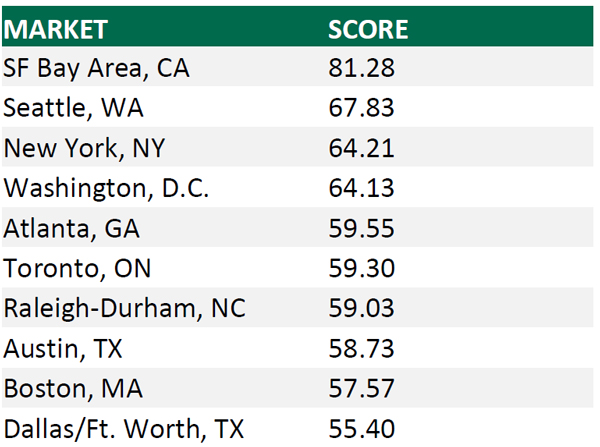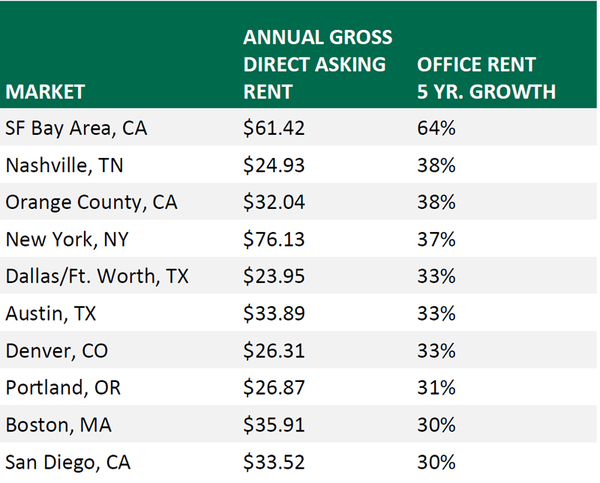The WPJ
THE WORLD PROPERTY JOURNALReal Estate Facts Not Fiction
Commercial Real Estate News

War On Acquiring Tech Talent Driving Up Startups Office Rents
Commercial News » San Francisco Edition | By Michael Gerrity | July 20, 2017 9:00 AM ET
Companies Now Willing to Pay Rent Premiums in Tech Heavy Urban Cities
According to CBRE's newly released Scoring Tech Talent Report, strong demand for key tech skills such as software development, hardware engineering and information security, coupled with a tight labor supply, is driving companies to locate in markets with the largest concentrations of high-quality talent like Northern California and Manhattan. And while value is a key driver when it comes to choosing an office location, companies are showing that they are willing to pay a premium to access the highest quality tech talent.
Overall cost variances from market to market are striking: Taking both talent and real estate costs into consideration, the "typical" U.S.-based, 500-person tech company needing 75,000 sq. ft. of office space can expect its total annual cost to range from $24 million in Vancouver, the least expensive of the 50 markets included in the CBRE report, to $57 million in the San Francisco Bay Area, the most expensive market.
According to CBRE's analysis, which can be viewed in detail through the interactive Tech Talent Analyzer, the best-value markets with the highest quality of talent are Toronto and Vancouver (due in part to the strong U.S. dollar) followed by Indianapolis, Pittsburgh and Detroit.
"Since the cost of talent is the largest expense for most firms, the quality of that tech talent is becoming one of their most important considerations. The skills of the available labor pool do not appear to align with available jobs, causing a structural impediment to growth for companies across North America," said Colin Yasukochi, director of research and analysis for CBRE in the San Francisco Bay Area.
"Only 37 percent of all tech-talent workers are employed in the high-tech industry, meaning tech companies must compete with other industries that employ the remaining 63 percent of tech workers. In addition, the unemployment rate for college-educated workers is around 2.3 percent in the U.S., further stiffening competition. All of this means that, more than ever before, top tech talent comes at a cost today," he added.
Tech Talent Scorecard
Atlanta and Toronto are the big stories on this year's Tech Talent Scorecard. Atlanta entered the top five for the first time along with traditional stalwarts like San Francisco Bay Area, Seattle, New York and Washington, D.C. Atlanta bumped Austin out of the top five, which fell back to number 8. Atlanta is one of the few large markets that maintained its fast pace of tech talent growth and has an accelerated forecast for future tech job creation, which elevated its position in the rankings.
Meanwhile, Toronto jumped a full six spots to number 6, from last year's number 12. The elevated ranking was due to its talent employment base growing by the highest number of workers.
The rankings for the Tech Talent Scorecard are determined based on 13 unique metrics including tech talent supply, growth, concentration, cost, completed tech degrees, industry outlook for job growth, and market outlook for both office and apartment rent cost growth.
The top 10 cities on the Tech Talent Scorecard were all large markets, each with a tech labor pool of more than 50,000:

Rounding out the top 15 were Baltimore, Denver, Newark, N.J., Orange County, Calif. and Chicago. Denver and Newark were new this year in the top 15, bumping Phoenix and Minneapolis to number 17 and 18, respectively. Of note, Vancouver also made a strong showing this year at number 16.
Top Momentum Markets
Tech job growth gained momentum in 28 of the 50 markets. This means job creation grew faster in the past two years (2015-2016) compared with the prior two-year period (2013-2014). The number of markets experiencing faster growth almost tripled from 10 markets in last year's Scoring Tech Talent report. The top 10 momentum markets and their associated tech talent growth rates were:
"This year's report shows the top 10 markets for momentum are all moderately priced and grew at least 10 percent faster than during the prior two-year period. Tech employment growth has a multiplier effect that positively impacts economic growth, which in turn can have an immense impact on commercial real estate activity," said Mr. Yasukochi.
Commercial Real Estate Market Impact
The high-tech industry's share of major leasing activity nationwide increased to 19 percent in 2017 from 11 percent in 2011--the largest single share of any industry. Accordingly, office rents are up in almost every market in the top 50 and vacancy has declined, with the biggest impact in the most tech-concentrated sub-markets.
Significant demand for office space in top tech-job-producing markets raised rents to their highest levels and pushed down vacancy rates to their lowest levels. Rent growth is most prominent in the large tech markets, with office rents in the San Francisco Bay Area two-thirds higher than five years ago. But the decrease in vacancy rates is present across both large and small tech markets. Vacancy rates in the San Francisco Bay Area and New York are the lowest of the top 50 tech talent markets, and some small markets like Madison and Nashville are not far behind.
The 10 markets with the most significant five-year rental rate growth include:
 Brain Gain or Drain?
Brain Gain or Drain? College graduates do not always remain in the labor market where they earn their degrees; they often migrate to locations that offer the best job opportunities and pay. Analyzing tech-related graduation data and tech-related employment growth, CBRE calculated the difference between where tech talent workers are employed and where they were educated. Tech degrees cover the most recent five-year period available (2011-2015) and tech jobs added cover the time period when most graduates would be counted in employment figures (2012-2016).
Not surprisingly, the San Francisco Bay Area stands out as a strong tech-job creator and tech talent attractor, with nearly 80,500 more tech jobs than graduates, followed by eight markets that added 10,000+ more jobs than graduates. On the other end of the spectrum, Los Angeles, Washington, D.C., and Boston produce a significant number of tech graduates, but post a deep deficit when it comes to employing them locally.
Sign Up Free | The WPJ Weekly Newsletter
Relevant real estate news.
Actionable market intelligence.
Right to your inbox every week.
Real Estate Listings Showcase
Related News Stories
Commercial Real Estate Headlines
- 2025 Prediction: U.S. Commercial Investment Recovery Expected to Gain Traction
- Holiday Retail Sales for 2024 to Hit Record $1 Trillion
- Tech, AI Industries Drive Largest Share of Office Leasing Activity in U.S.
- Commercial Real Estate Lending in U.S. Enjoys Strong Growth in Q3
- U.S. Multifamily Market Begins Recovery in Q3
- Commercial Investment in Japan Spikes 24 Percent Annually in Q3
- Despite Return-to-Office Mandates, U.S. Office Vacancies Continue to Rise
- PROPSIG Tech Startup Acquired by World Property Data
- U.S. Commercial Mortgage Debt Hits $4.7 Trillion in Q2 as Delinquencies Increase
- Hong Kong Class A Office Rents Continue to Downtick in Mid-Summer
- U.S. Office Landlords Tenant Concessions Decline for First Time in 4 Years
- U.S. Commercial Mortgage Originations Spike 27 Percent in Q2 Over Q1
- Phnom Penh's Commercial Office, Retail Markets Face Slowdowns in 2024
- Global Edge Data Center Market to Hit $300 Billion by 2026
- Commercial Property Transactions in Japan Dive 25 Percent Annually in Q2
- Delinquency Rates for U.S. Commercial Property Loans Downticks in Q2
- Megawarehouse Lease Deals in U.S. Increase in 2024
- Office Tenants' Flight to Quality Buildings Increases in 2024
- Commercial Lending in Japan Upticks 6 Percent Annually in Q1
- AI Driving Significant Global Data Center Growth in 2024
- Total U.S. Commercial Mortgage Debt Rises to $4.7 Trillion in Q1
- U.S. Commercial Mortgage Delinquencies Rise in Early 2024
- Asia Pacific Office Sector to Further Reprice Throughout 2024
- U.S. Retail Foot Traffic to Surpass Pre-Pandemic Levels by 2025
- Commercial Real Estate Lending in U.S. Slowed in First Quarter
- Japan Commercial Property Investment Volume Jumps 7 Percent in Q1
- Asia Pacific Commercial Property Investment Leads the World, Spikes 13 Percent
- Driven by High Rates, U.S. Commercial Lending Imploded 47 Percent in 2023
- After Two Year Slump, Prime Multifamily Metrics Uptick in U.S.
- Commercial Co-Broker Commissions Not Affected by NAR-DOJ Settlement, Yet
- U.S. Office Buildings with Upscale Tenant Amenities Still Enjoy Premium Rents in 2024
- U.S. Commercial, Multifamily Mortgage Delinquency Rates Uptick in Q4
- U.S. Commercial Mortgage Debt Continued to Rise in 2023, Hits $4.7 Trillion
- Nonresidential Construction Spending in the U.S. Falls Sharply in January
- U.S. Multifamily Construction Starts to Decline in 2024
- Commercial Mortgage Lending in U.S. Shows Signs of Stabilization in Late 2023
- Architecture Billings Decline in December as Soft Business Conditions Persist
- Government Sector Claimed Largest Portion of 100 Biggest U.S. Office Leases Signed in 2023
- U.S. Commercial, Multifamily Borrowing Dives 25 Percent Annually in Late 2023
- Record High Multifamily Construction Deliveries Drive Vacancy Rates Higher
Reader Poll
Marketplace Links
This website uses cookies to improve user experience. By using our website you consent in accordance with our Cookie Policy. Read More





